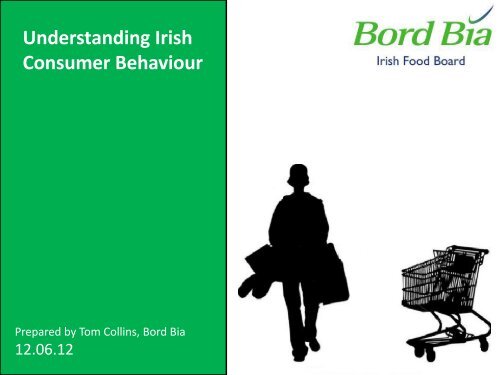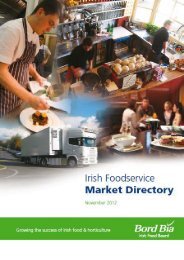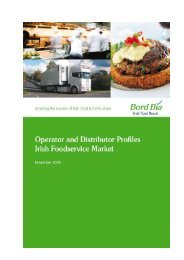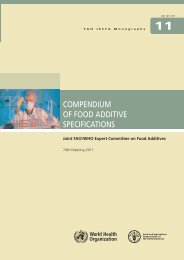Understanding Irish Consumer Behaviour - Bord Bia
Understanding Irish Consumer Behaviour - Bord Bia
Understanding Irish Consumer Behaviour - Bord Bia
You also want an ePaper? Increase the reach of your titles
YUMPU automatically turns print PDFs into web optimized ePapers that Google loves.
<strong>Understanding</strong> <strong>Irish</strong><strong>Consumer</strong> <strong>Behaviour</strong>Prepared by Tom Collins, <strong>Bord</strong> <strong>Bia</strong>12.06.12
The importance of understanding the consumerTo gain an understanding of the consumer, we must first understand their lives, theirconsumption patterns, their relationship with categories and the brands that they choose.Shopper insights are currency for building strong customer relationships.Retailers are battling for consumers and seek manufacturer partners who bring insightsabout how people shop that translate into ideas that increase traffic, category and aislesales.But very often brand managers knowledge of consumers isn’t always as strong. Knowledgeabout how and why consumers behave doesn’t necessarily equate to knowledge about howthey behave when shopping.For instance time pressure, the nature of their shopping trip, who is accompanying them,promotions, whether they are buying as a gift and so on.Due to the changing global economic climate, understanding the consumer is moreimportant than ever since consumer behaviour is changing and retailers must work harder tomaximise revenue.
Global <strong>Consumer</strong>Trends
Global <strong>Consumer</strong> TrendsBefore we can understand the <strong>Irish</strong> consumer, an understanding of the global consumer andtheir trends should be acknowledged as these trends shape the marketplace for <strong>Irish</strong>manufacturers and retailers.<strong>Bord</strong> <strong>Bia</strong>’s global 2012 <strong>Consumer</strong> Lifestyle Trends programme identifies those global trendswhich exist today.We describe a trend as a sustained change in consumer attitudes, needs, wants and behaviours.The drivers help us understand the nature of the forces behind the trends. Large scale,sustained and measurable economic, social, political, technological and environmental influencesshaping people's attitudes, values and behaviors at a global and local level.We have identified 6 global consumer trends which are as follows;
“I want to manage my busy life and make sure that I am atmy best for whatever the day presents”Life is still busy and finding time to fit in everything we want remains a challenge. Convenienceis still king. But, financial pressures mean that this cannot come at any price.For some, life has slowed as the economy has slowed and work pressures have eased, makingmoments to slow down and take time out more accessible. For others, pressures remain high andthe pace of life still feels relentless, time out is needed to unwind or recharge.People have become more aware that maintaining energy levels is critical in order to get themost from what the day presents; avoiding peaks and slumps, and maintaining concentration andfocus are top of mind.Food and drink plays a critical role and people are becoming more sophisticated in theirapproach to managing their mental and physical energy needs.The sub-trends for Fluid Lives are;Simple by Design–solutions that reduce complexity or save timeWinding Down – talks about slowing down and escaping to recharge the body and mindConveniently There- Describes the need for ever improved convenience and portabilityGuided Choice– ways to make good choices quickly and easilyPeak Performance – Managing your physical and mental performance throughout the day
How <strong>Irish</strong> <strong>Consumer</strong>s follow this trend<strong>Irish</strong> <strong>Consumer</strong>s are following this trend by taking greater control of their time and making themost of their free time, whilst placing emphasis on spending time together as a family.“It’s important for me to get a greater senseof control in every aspect of my life.”89% of <strong>Irish</strong> consumersthink that is importantto spend time overdinner as a family81% of <strong>Irish</strong> consumers agree65% of <strong>Irish</strong> <strong>Consumer</strong>s cook meals from scratch at least a few times a week, increasingyear on year. <strong>Consumer</strong>s have more free time at home to prepare these meals.16% of ROI consumers state that compared to 12 months ago, they are cooking fromscratch more often.35% of ROI consumers explain that they use convenience meals less often compared to 12months ago, this figure increased by 5% from 2009.There is more time spent together as family as 49% of consumers report that they sit downfor breakfast everyday as a family.
“I want to get more enjoyment from the simple things inlife; to have experiences that add more fun and meaning”The economic crisis has forced consumers to re-adjust their lifestyles, often changing thefoundations on which their lives are built.People are spending more quality time with others and trying new things in order to make lifemore enjoyable, even whilst managing on a budget.People are seeking to reach out again, either to connect with friends and family in different waysfrom the past or, to establish new connections with people who share their new found approach tolife.People are setting their own goals to gain a sense of achievement and rebuild a sense of pride or,indulging in small rewards and moments of fun in order to feel they are more than just getting by.The sub-trends for Making the Most of Life are;Fun and Play – enjoyment through play and noveltyCo-Creation– The enjoyment and fun of being part of the creative processEnhanced Sensations–Desire for intensifies sensory experiencesSeeking Connections– Making, maintaining or deepening connections with othersRich Rewards – Indulgent experiences that offer respite and rewardPassion and Purpose – Experiences that introduce new meaning, purpose or goals in life
How <strong>Irish</strong> <strong>Consumer</strong>s follow this trend<strong>Irish</strong> <strong>Consumer</strong>s are following this trend as they make more use of their free time by trying newfoods and improving their cooking skills.“I really enjoy cooking and being ableto create a great meal”65% of <strong>Irish</strong> consumers agree“Some of the dreams I hadfor myself before therecession are nowprobably out of my reach.”70% of <strong>Irish</strong> consumers agree46% of <strong>Irish</strong> consumers regularly look up recipes online to give them ideas and new flavours/meals.More consumers are embracing online technology to help them discover new recipes and foods.35% of ROI consumers have downloaded a recipe from the internet.18% have downloaded a food based application for their phone.1 in 10 consumers have attended a cookery class in the last 3 years, up 3% from 2009.70% of <strong>Irish</strong> consumers agree that since the recession they have learned how manythings they can do with out and still be happy.4 in 10 consumers see cooking as good fun at times or as a passion as they love food.
“I am mindful that I need to live more responsibly; I wantto make better choices that make a difference withouthaving to compromise”Social and environmental concerns remain of high importance for people. But high prioritydoes not always mean the top priority and, many people seek to balance the issues of ethics andfinances as well as they can manage. Affordable choices and easy to do actions resonate withpeople wanting to live more responsibly.When considering more responsible choices, where the outcome is more tangible, the benefitis clearer. Where the outcome leads to a local or personal benefit (as well as a wider social orenvironment benefit), the choice is more motivating.As concern is heightened through either direct exposure or media attention, many people areincreasingly looking toward companies and institutions to lead the way; expecting real proof ofthe positive impacts they claim to make.The sub trends for Sustainable Lives include:Conserving Resources–living in a world where resources are increasingly in short supplyGood Causes – explains how consumers are supporting a worthy cause through purchase choicesFair Treatment – is about treating animals and people fairly in the production process.Climate Conscious – focuses on protecting the world’s environment and biodiversityWar on Waste – highlights the drive to reduce the wasteful results of consumption
How <strong>Irish</strong> <strong>Consumer</strong>s follow this trend<strong>Irish</strong> <strong>Consumer</strong>s are following this trend as we see that <strong>Irish</strong> consumers are conscious ofenvironmental issues and these can affect their purchasing behaviour.“I have made it a top priority to livean environmentally consciouslifestyle”34% of <strong>Irish</strong> consumers agree“Since the recession Ifeel a greater need to beas self sufficient aspossible”76% of <strong>Irish</strong> consumers agree44% of <strong>Irish</strong> <strong>Consumer</strong>s don’t believe the claims made by environmentally friendlyproducts.55% of ROI consumers state that they prefer to buy from companies that aware of theimpact of environmental issues., an increase of 6% from 2009.37% of ROI consumers explain that they try to buy FairTrade products whenever they areavailable and 34% of consumers wish that there were more FairTrade products available.65% of <strong>Irish</strong> consumers are aware of the term “Carbon Footprint” and 47% of consumershave not heard of the term “Food Miles”.66% of <strong>Irish</strong> consumers agree that they try to make better use of leftover food.
“I want a balanced approach to health and wellness, tohave greater control through the choices I can make”Brands and institutions continue to help educate people about how to live more balanced lifestylesand make healthier choices. But with levels of information and options reaching overwhelminglevels, people often struggle to navigate the complex array of choice now at their fingertips. Findingthe right strategy and approach to health and wellness has become a key challenge.With financial constraints creating added pressures, many people have begun to adopt a morebalanced approach to life and their diets, recognising that whilst physical health is important, theirmental health and outlook on life is equally as important.Food is becoming core to people’s health strategies and overall sense of wellbeing, whether theyare looking for healthier options that do not compromise on quality and a feeling of indulgence orsolutions that set their children up for a good start to life and a healthier future.The sub trends for Quest for Health & Wellness are;Proactive Prevention– Proactively defending the body against future illness via healthier choicesFinding Balance – Looking for emotional and physical balance via nutrition and lifestyleImage Control –Managing weight and external appearanceGood Start–Ensuring children get the best start in lifeNaturally Good– searching for the best from nature to improve healthCoping Strategies - using or excluding products in a response to modern day ailments
How <strong>Irish</strong> <strong>Consumer</strong>s follow this trend<strong>Irish</strong> <strong>Consumer</strong>s are following this trend by managing their diet and increasing their intake offruit and veg.”I consider what I eat, too be reallyimportant for my wellbeing”42% of <strong>Irish</strong> consumers statethat they are satisfied withtheir physical health79% of <strong>Irish</strong> consumers agree92% of <strong>Irish</strong> <strong>Consumer</strong>s try to eat a lot of fruit and vegetables, however only 11% onaverage eat more than 5 pieces of fruit and veg a day.72% of ROI consumers state that they try to eat foods that are low in fat and 71% tend toavoid sugary foods/sweets.62% of consumers have made it a top priority to live a healthy lifestyle.67% agree that they eat healthy to maintain more control in their life but 39% are confusedas to what to eat to stay healthy.58% of <strong>Irish</strong> consumers would like to see more low fat options and 60% often find itdifficult to understand the nutritional claims on packaging.
“I like to pursue better value, to help maintain mylifestyle and to get the most from the money I have”The financial crisis has fundamentally changed attitudes to the marketplace and what representsgood value; consumers are smarter and savvier with their money and more willing to shop aroundthan ever before. Budgeting is now the norm for many, who have devised tools to keep theirspending in check.Being a well known brand is no longer enough as consumers look for more proof points of thebenefits products claim to offer, whether taste, quality or nutritional value.People are devising their own solutions to get more for their money: buying and cooking in bulk,opting for loose vegetables rather than pre-packed, substituting cheaper alternatives for regularpurchases and finding ingredients that allow variety and creativity in their use.The sub-trends for <strong>Consumer</strong>s in Control are;Redefining Value– deepening desire for good value beyond the price aloneExpert Status- growth in pursuit of knowledge and discernment for identity and statusTangible Benefits– focusing on proof of real tangible benefits and established qualityCounselled Consumption– the rise of specialist advisors and peer reviews for all consumptionsExclusive Choices- there is a growing demand for exclusivity and rarity
How <strong>Irish</strong> <strong>Consumer</strong>s follow this trend<strong>Irish</strong> <strong>Consumer</strong>s are following this trend by maintaining control in their finances and simply byplanning their shopping and cooking to achieve value.“Whether or not my finances improve,I am likely to write out shopping lists.”69% of <strong>Irish</strong> consumers agree“I'll never spend my money again asfreely as I did before the recession.”67% of <strong>Irish</strong> consumers agree74% of <strong>Irish</strong> <strong>Consumer</strong>s agree that they are more likely to consider the risks of each decisionthat they make so as to maintain control and maximise value.47% of <strong>Irish</strong> <strong>Consumer</strong>s like to splurge on some products/services even if it means that theyhave to economise more radically in other areas.56% agree that if they purchase something that wasn’t on sale, they feel like they haveoverpaid.However consumers are sceptical of retailers when looking to maintain control and managefinances as 43% of consumers agree that “supermarket deals always come with a catch”.56% of consumers agree that Promotions like 'buy one get one free' are just a way forshops to make more money”.
“I am looking for products and brands that are real, authenticand honest, because I know I can trust what's in them andwhere they come from”As the recession struck, brands that had stood the test of time and remained true to their valuesbecame points of stability and comfort amongst the turmoil. But as life has settled into new routinesthe meaning of authenticity is changing.The past has to have modern relevance to maintain its meaning and value; genuine benefits need tolie behind the origins or craftsmanship that is used in their making. Provenance or sourcing need todeliver unique or distinctive product attributes.Locality and seasonality are becoming increasingly important; and are seen as a way of accessingproducts at their best whilst protecting local interests.The sub-trends for Keeping it Real are;Back to Basics – adopting traditional approaches and skills to meet today’s needsCelebrating Tradition – taking the best tradition and heritage to meet modern tastesCraftsmanship – there is a rising interest in the people and artisan skills behind productsBehind the Scenes – Transparency is now a mark of quality and trustPassion for Place – We are seeing a growing interest origin as a mark of quality and trustEmbracing the Seasons –growing interest in consuming seasonal produce
How <strong>Irish</strong> <strong>Consumer</strong>s follow this trend<strong>Irish</strong> consumers are following this trend as they move back to basics with regards to cooking andpurchasing items that they may not really need.“Since the recession, I feel a greaterneed than ever to be as self-sufficient aspossible.”“It is important to buy local productsto support the economy, even if theysometimes cost more.”78% of <strong>Irish</strong> consumers agree70% of <strong>Irish</strong> consumers agree71% of <strong>Irish</strong> <strong>Consumer</strong>s agree that since the recession, they have learnt that they can do withoutmany things and still be happy.In keeping with the simpler times and buying local, 64% of consumers agree that it is importantto buy <strong>Irish</strong> to help support the economy, even if they cost more.74% of <strong>Irish</strong> consumers agree that it is extremely/very important to learn new things in their life51% of consumers buy “local food” at least once a week/few times a week.66% of <strong>Irish</strong> consumers are more likely to spend the time researching a product beforemaking a purchase.
The <strong>Irish</strong><strong>Consumer</strong> & theEconomic Climate
The <strong>Irish</strong> <strong>Consumer</strong> in today’s economic climateThe economic situation in ROI and GB still remains difficult and a return to a level of growth thatwill improve prospects for consumers in the imminent future appears unlikely.Our unstable economic situation has led to changing shopping behaviours and by understandingthe consumer we can achieve a deeper insight into how they were coping with currentcircumstances.There are 3 consumer groups that have been segmented according to their financial situationand their ability to cope with the current economic climate;All Hands on Deck: This group has been most affected by the recession, for example one in sevenhave been made redundant in the last 12 months, and, as a result, they have been obliged toradically review their lifestyles and reduce their debts– 40% of <strong>Consumer</strong>sChoppy Waters: <strong>Consumer</strong>s here have not had to make the dramatic changes of those in theabove group, but have become more careful with their money in order to maintain as much of theirpre-recession lifestyles– 39% of <strong>Consumer</strong>sPlain Sailing: This group is less likely to have been directly affected, being lessfinancially exposed and with fewer commitments. <strong>Consumer</strong>s here are older, over athird have paid off their mortgages and very few still have children at home to support- 21%of consumers
Despite the pressures on price,brands have a great opportunity toconnect more deeply with consumers intoday’s environmentRoom now exists for brands to fillsome of the void in consumers’ lives,something that if they can, is likely to berewarded with loyalty and advocacy.We have also identified five ‘P’s thatoutline how brands can help consumersin today’s environment. They are notdesigned to replace the other ‘P’s ofmarketing but add to them to helpcompanies build better positioning &create better brand plans.PPPPPNew ‘P’s of marketingPROTECTION:Protecting consumers fromuncertainty and riskPRACTICAL:Helping consumers to plan and bemore self-reliantPERMISSION:Encouraging consumers to makeconnections and see the positives of a lifewith lessPURPOSE:Giving consumers new meaningand purpose to their livesPRIDE:Re-building a sense of pride andachievementNot all consumers have been affected equally by the recessionRecognising that different groups have different coping strategies and mechanismswill be critical. Those businesses that are able to target and communicate in such away that aligns with the sensibilities and priorities of each group is likely to findgreater value in the market place.
ShopperArchetypes
There are 4 Key Shopper TypologiesWhat type of shopper are you?The Browser6%The BargainHunter18%The Quick Shopper48%The Careful Shopper28%
The Quick ShopperThe quick shopper’s characteristics are;Autopilot ShoppingKnows the store layoutLikes to stock upBrand Loyal“Grocery shopping is a job, something toget over and done with. I don’t want towaste my time in a supermarket I have toomany other things to fill my life”The quick shopper doesn’t necessarily enjoyshopping but views it as a means of completing a list,whether it be mental or written.18-21 22-29 30-45 45-59 60+TOTAL SAMPLE 5% 13% 34% 28% 17%THE QUICK SHOPPER 7% 19% 33% 27% 14%MALE FEMALETOTAL SAMPLE 17% 83%THE QUICK SHOPPER 27% 73%ABC1 C2D E FTOTAL SAMPLE 49% 35% 13% 1%THE QUICK SHOPPER 56% 31% 12% 1%
The Careful ShopperThe careful shopper’s characteristics are;Immerse themselves in the experience of shoppingHigh involvement levelsEngaged in store cultureShopping is stimulating for the careful shopper, but it isstill a job and something to be conscientious about.For the careful shopper, bargains aren’t the main focus,instead it is value.Food shopping, in particular, issomething to take seriously. Time isspent at the category fixture reviewingprices, brands, formats andingredients.18-21 22-29 30-45 45-59 60+TOTAL SAMPLE 5% 13% 34% 28% 17%THE CAREFUL SHOPPER 1% 8% 39% 29% 23%MALE FEMALETOTAL SAMPLE 17% 83%THE CAREFUL SHOPPER 10% 90%ABC1 C2D E FTOTAL SAMPLE 49% 35% 13% 1%THE CAREFUL SHOPPER 46% 37% 16% 1%
The Bargain HunterThe bargain hunter’s characteristics are;Visit many retailersOffer “destinations” drives their behaviourShopping is a war and one that you have toconstantly be alert to win.Word-of-mouth and advertising are relied upon forthe greatest deals.Overtly price conscious and therefore treatsgrocery shopping as a challenge. Price andvalue are the key considerations so strategiesare used to seek out the best value.18-21 22-29 30-45 45-59 60+TOTAL SAMPLE 5% 13% 34% 28% 17%THE BARGAIN HUNTER 4% 10% 35% 34% 16%MALE FEMALETOTAL SAMPLE 17% 83%THE BARGAIN HUNTER 11% 89%ABC1 C2D E FTOTAL SAMPLE 49% 35% 13% 1%THE BARGAIN HUNTER 34% 53% 11% 2%
The BrowserThe browser’s characteristics are;Shopping is a form of stimulationSometimes an “idea” and inspiration exercise for consumersWill compromise on price for a more enjoyable shopping experienceThe browser enjoys new foods and new tastesand they know what they need to purchase butsometime the supermarket is used as a catalystfor new purchases.Some of us genuinely enjoy theexperience of shopping and love to takeour time in the supermarket.18-21 22-29 30-45 45-59 60+TOTAL SAMPLE 5% 13% 34% 28% 17%THE BROWSER 4% 11% 27% 29% 29%MALE FEMALETOTAL SAMPLE 17% 83%THE BROWSER 13% 87%ABC1 C2D E FTOTAL SAMPLE 49% 35% 13% 1%THE BROWSER 66% 16% 18% 0%
What does thismean for you?
Food for ThoughtThe economic uncertainty will inevitably cause problems for some retailers as consumerslook for value points.The obvious benefits of quality and provenance have to be considered as essentialelements of the brand and marketing mix.Labelling, product information, branding and communications will need to be consistentand really ensure that the products stand out from the crowd.Retailers will need to be creative in how they retain market share, they will need toconstantly promote their products and educate about the benefits.<strong>Irish</strong> consumers will need to be enticed to remain buying <strong>Irish</strong> and local and not beseduced by non <strong>Irish</strong> ‘local’ brands.Developments in technology will have a variety of effects.Ease of access to information on produce means all suppliers will need to be clearabout pricing, ingredients, any eco-credentials etc.Online and mobile commerce will not be going away , they are part of the shoppingmix for any consumers already.
<strong>Irish</strong> Brands Must.....demonstrate they are competitive via in-store visibility.remind shoppers they are <strong>Irish</strong> in-store.facilitate stocking up.constantly reinforce their quality through innovation.offer value through new formats.constantly reinforce their quality through communications.facilitate stocking up with multi-pack format offers.
The Future of the<strong>Irish</strong> <strong>Consumer</strong>
InsightConvenience for on-the-go ProductsIncrease of Healthy SnackingReduced IngredientsFocus on freshnessSustainable packagingMore single households and need for easyserve itemsOnline grocery shopping will double in 5 yrsSmart shopper promotions increasingUser generated opinionBrand value shifting to retailerExplanation<strong>Consumer</strong>s are eating breakfast during commute, lunch atdesk and all-day snackingProtein led snacks are on the rise<strong>Consumer</strong>s are increasingly demanding fewer ingredientsand additives<strong>Consumer</strong>s place great importance on the term “fresh”and it is up to the retailers to deliver thisPressures from consumers and legislators increase priorityof sustainabilityMore demand for options for single households orindividuals<strong>Consumer</strong> trust in the format is growing and broadbandpenetration increases<strong>Consumer</strong>s are taking up clever promotions or groupbuy/online savingsAmateur food critics have an increased influenceonline with product feedbackRetailers’ own private label brands are astrusted, as some “brands”
The following is the list ofreports that were used in thispresentation;•PERIscope 6•Continental PERIscope 2010•Feeling the Pinch 6•<strong>Consumer</strong> Lifestyle Trends 2012•Retaining Loyalty to <strong>Irish</strong> Brands•Evening Meals ResearchAll of our reports are available onlinewww.bordbia.ie/publications





